小升初英语总复习课件:第六章 短文阅读(17张ppt)
文档属性
| 名称 | 小升初英语总复习课件:第六章 短文阅读(17张ppt) | 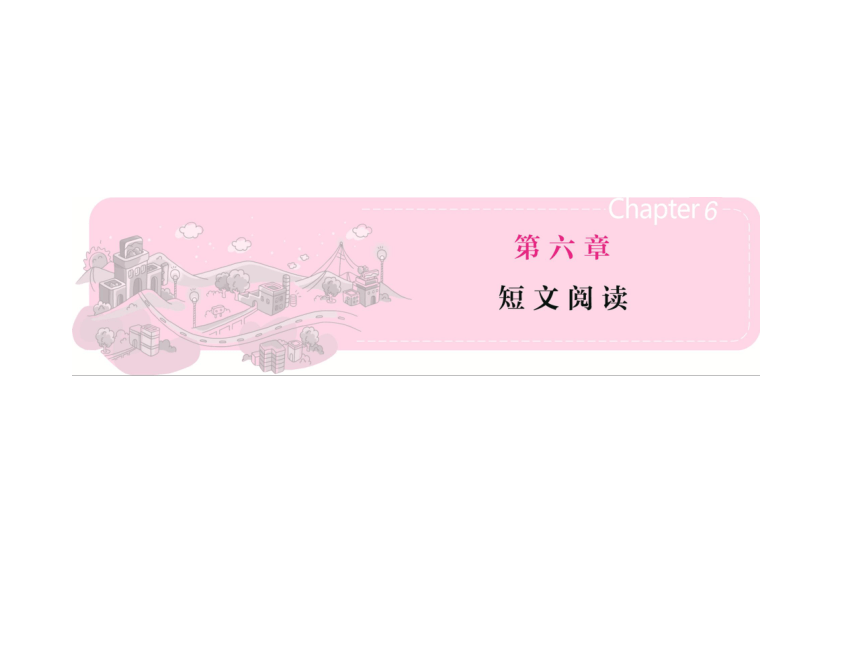 | |
| 格式 | ppt | ||
| 文件大小 | 1.2MB | ||
| 资源类型 | 教案 | ||
| 版本资源 | 人教版(PEP) | ||
| 科目 | 英语 | ||
| 更新时间 | 2021-03-02 17:58:53 | ||
图片预览

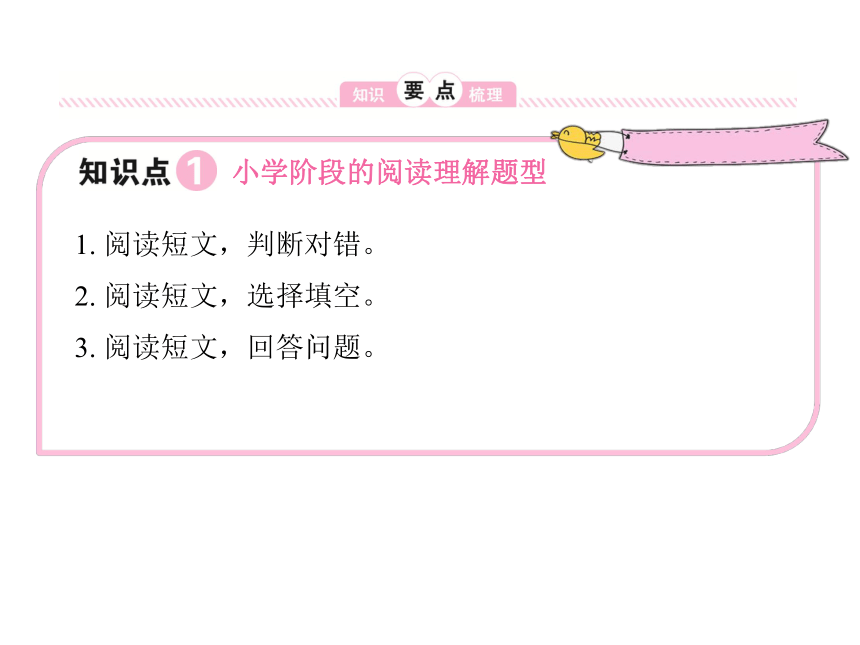
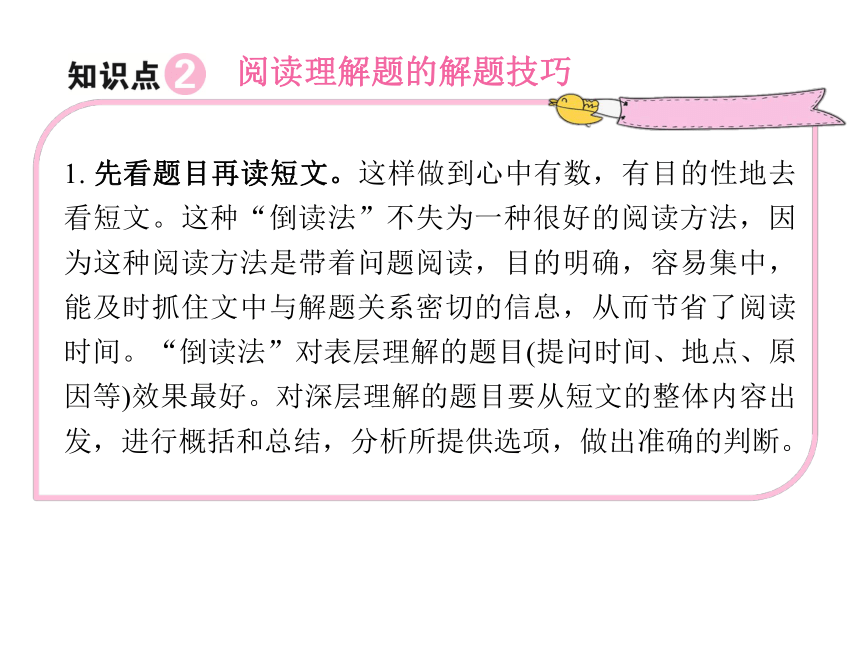
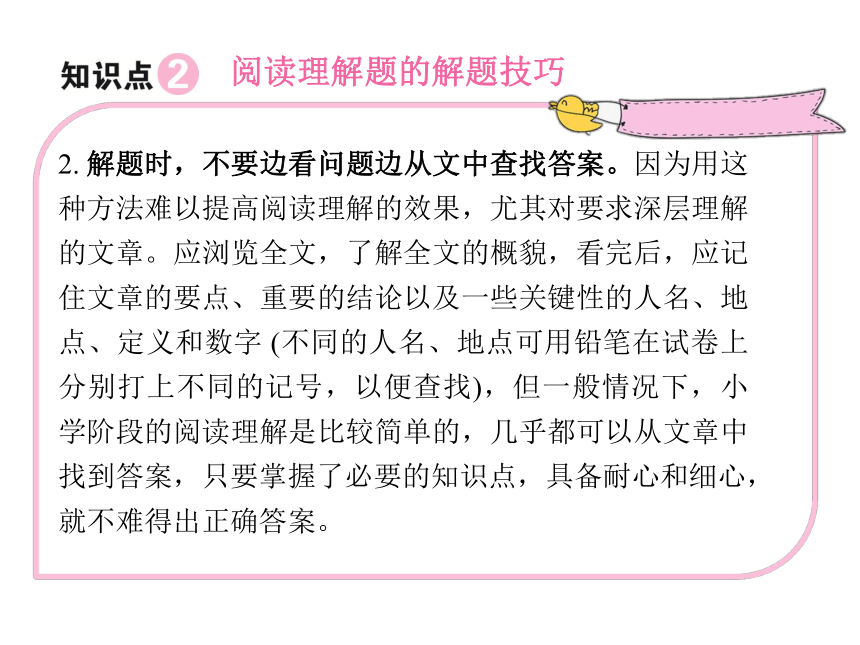
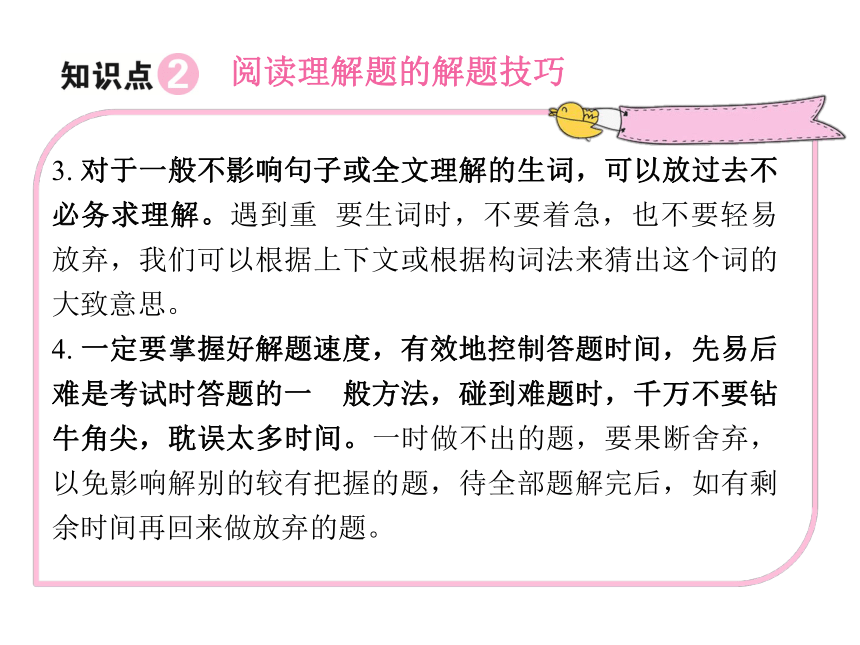
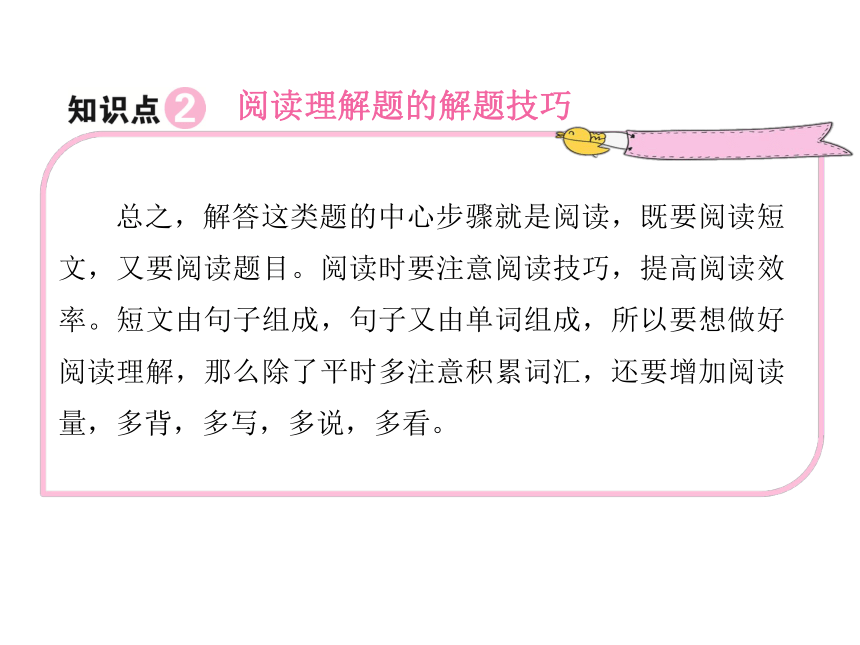

文档简介
小学阶段的阅读理解题型
1. 阅读短文,判断对错。
2. 阅读短文,选择填空。
3. 阅读短文,回答问题。
阅读理解题的解题技巧
1. 先看题目再读短文。这样做到心中有数,有目的性地去看短文。这种“倒读法”不失为一种很好的阅读方法,因为这种阅读方法是带着问题阅读,目的明确,容易集中,能及时抓住文中与解题关系密切的信息,从而节省了阅读时间。“倒读法”对表层理解的题目(提问时间、地点、原因等)效果最好。对深层理解的题目要从短文的整体内容出发,进行概括和总结,分析所提供选项,做出准确的判断。
阅读理解题的解题技巧
2. 解题时,不要边看问题边从文中查找答案。因为用这种方法难以提高阅读理解的效果,尤其对要求深层理解的文章。应浏览全文,了解全文的概貌,看完后,应记住文章的要点、重要的结论以及一些关键性的人名、地点、定义和数字 (不同的人名、地点可用铅笔在试卷上分别打上不同的记号,以便查找),但一般情况下,小学阶段的阅读理解是比较简单的,几乎都可以从文章中找到答案,只要掌握了必要的知识点,具备耐心和细心,就不难得出正确答案。
阅读理解题的解题技巧
3. 对于一般不影响句子或全文理解的生词,可以放过去不必务求理解。遇到重 要生词时,不要着急,也不要轻易放弃,我们可以根据上下文或根据构词法来猜出这个词的大致意思。
4. 一定要掌握好解题速度,有效地控制答题时间,先易后难是考试时答题的一 般方法,碰到难题时,千万不要钻牛角尖,耽误太多时间。一时做不出的题,要果断舍弃,以免影响解别的较有把握的题,待全部题解完后,如有剩余时间再回来做放弃的题。
阅读理解题的解题技巧
总之,解答这类题的中心步骤就是阅读,既要阅读短文,又要阅读题目。阅读时要注意阅读技巧,提高阅读效率。短文由句子组成,句子又由单词组成,所以要想做好阅读理解,那么除了平时多注意积累词汇,还要增加阅读量,多背,多写,多说,多看。
阅读短文,判断对错
例1 读下面的一封信,并判断正误。(对的写“T”,错误的写 “F”)
Dear Gao Shan,
I am writing to you in my bedroom. I miss(想念) you and the other classmates in China. Now,I live with my parents in the USA. I'm studying in a primary school in Atlanta(亚特兰大). I'm not good at English. My friend Tim is from England. He often helps me with my English. And I teach him Chinese.
All of my classmates here are very interesting. Peter is English. David is Australian. Nancy is American. She's from New York. Mr.Black is my teacher. He's from Canada. My good friends, Gao Lin and Wu Yi are Chinese, too. They're from Hong Kong.
We're from different countries, but we are friends. I will come back this Spring Festival.
Yours,
Liu Tao
( )1. Liu Tao is American.
( )2. Liu Tao often teaches Tim Chinese.
( )3. Peter and David are from the same country.
( )4. Mr.Black isn't Chinese. He's Japanese.
( )5. Now Liu Tao and his classmates are in the USA
阅读短文,判断对错
阅读短文时,首先要认真阅读需要解答的题目,做到心中有数,然后带着问题有目的地去看短文。在阅读过程中遇到相关的信息的时候用铅笔画下来,这样就会一目了然,这样做还有一个目的,便于检查。这个阅读理解中有少量生词,但已标注出来,不影响阅读。这篇阅读文章是一封信,要弄清楚谁是写信人,谁是收信人,才更便于做题。
答案 1. F 2. T 3. F 4. F 5. T
阅读短文,选择填空
例2 阅读短文,选择正确答案。
It's Sunday. It's a fine day today. My parents and I go to the new park near my house.
The park is big and beautiful. On my left, there is a cafe. On my right, there is a big lake. There are many flowers and trees near the lake. There's a small hill behind the lake. Near the lake, there is a sign. It says, “Don't swim in the lake!” There is a playground in the middle of the park. There are some small shops near the gate.
We have a good time in the park!
( )1. The park near my house is ________.
A. small and beautiful
B. big and beautiful
C. clean and new
D. old and clean
( )2. Is there a cafe in the park? ________
A. Yes, there isn't. B. No, there isn't.
C. Yes, there is. D. No, there is.
( )3. People can't ________ in the lake.
A. swim B. fish C. boat D. play
( )4. The shops in the park are not ________.
A. small B. big C. good D. pretty
( )5. —Do they like the park? —________
A. Yes, they do. B. No, they do.
C. Yes, you do. D. No, they don't.
阅读短文,选择填空
这篇阅读是常规的选择题,在小学阶段,阅读理解还是比较浅显的,答案基本上都可以在短文中找出。解答本题,可在进行短文阅读后,运用“倒读法”,带着问题逐个分析回答。第1题要求解答对“the park”的特点认识,从第一段和第二段开头可得。第2题的答案可在第二段的第二句话中找到。第3题考查祈使句与陈述句的句式转换及句意理解。第4题可直接在第二段末尾找到关键词“small”,作否定判断。第5题属于信息综合判断题。
答案 1. B 2. C 3. A 4. B 5. A
阅读短文,回答问题
例3 阅读短文,回答问题。
Once, Goethe, the great German poet, was walking in a park. He was thinking about something when he noticed he came to a very, very narrow road. Just at that time, a young man came towards him from the other end of the road. It was too narrow for both of them to pass through at the same time. They stopped and looked at each other for a while. Then the young man said rudely, “I never make way for a fool.” But Goethe smiled and said, “I always do.” Then he turned back quickly and walked towards the end of the road.
阅读短文,回答问题
根据短文内容,回答问题。
1. Where was Goethe walking?
2. Who came towards Goethe from the other end of the road?
3. Was the road too narrow for both of them to pass through at the same time?
4. Did the young man make way for Goethe?
5. Who turned back quickly and walked towards the end of the road?
做此类型题目,先仔细阅读短文后所提出的问题,带着问题通读全文,把握文章意思,然后再研读跟问题相关的句子、句子的关键词、短语等;在此基础上再结合上下文进行分析判断,归纳提炼出问题答案的表述内容;记住要看清问题,不要答非所问,同时表述的句子内容要简洁明了、语法正确、语句通顺、书写规范,不要照搬照抄原文的句子。分析本题:
1. 所问的问题是“歌德正走在什么地方?”根Once,Goethe, the great German poet, was walking in a park.
(有一次,德国大诗人歌德正在一个公园里散步)就能做出回答。
2. 所问的问题是“谁从路的另一端向歌德走来?”根据Just at that time, a young man came towards him from the other end of the road.(就在那个时候,一个年轻人从路的另一端向他走来)就能做出回答。
3. 所问的问题是“这条路太窄两个人不能同时通过吗?”根据It was too narrow for both of them to pass through at the same time. (这条路太窄两个人不能同时通过)就能做出回答。
4. 所问的问题是“那个年轻人给歌德让路了吗?”根据Then the young man said rudely, “I never make way for a fool.”(然后,那个年轻人粗暴地说: “我决不会给一个傻瓜让路。”)就能做出回答。
5. 所问的问题是“谁很快转身走回去?”根据Goethe smiled and said, “I always do.” Then he turned back quickly and walked towards the end of the road.(歌德微笑着说:“我总是给傻瓜让路。”说完,他很快转身走回去)就能做出回答。
答案 1. In a park. 2. A young man. 3. Yes, it was.
4. No, he didn't. 5. Goethe.
1. 阅读短文,判断对错。
2. 阅读短文,选择填空。
3. 阅读短文,回答问题。
阅读理解题的解题技巧
1. 先看题目再读短文。这样做到心中有数,有目的性地去看短文。这种“倒读法”不失为一种很好的阅读方法,因为这种阅读方法是带着问题阅读,目的明确,容易集中,能及时抓住文中与解题关系密切的信息,从而节省了阅读时间。“倒读法”对表层理解的题目(提问时间、地点、原因等)效果最好。对深层理解的题目要从短文的整体内容出发,进行概括和总结,分析所提供选项,做出准确的判断。
阅读理解题的解题技巧
2. 解题时,不要边看问题边从文中查找答案。因为用这种方法难以提高阅读理解的效果,尤其对要求深层理解的文章。应浏览全文,了解全文的概貌,看完后,应记住文章的要点、重要的结论以及一些关键性的人名、地点、定义和数字 (不同的人名、地点可用铅笔在试卷上分别打上不同的记号,以便查找),但一般情况下,小学阶段的阅读理解是比较简单的,几乎都可以从文章中找到答案,只要掌握了必要的知识点,具备耐心和细心,就不难得出正确答案。
阅读理解题的解题技巧
3. 对于一般不影响句子或全文理解的生词,可以放过去不必务求理解。遇到重 要生词时,不要着急,也不要轻易放弃,我们可以根据上下文或根据构词法来猜出这个词的大致意思。
4. 一定要掌握好解题速度,有效地控制答题时间,先易后难是考试时答题的一 般方法,碰到难题时,千万不要钻牛角尖,耽误太多时间。一时做不出的题,要果断舍弃,以免影响解别的较有把握的题,待全部题解完后,如有剩余时间再回来做放弃的题。
阅读理解题的解题技巧
总之,解答这类题的中心步骤就是阅读,既要阅读短文,又要阅读题目。阅读时要注意阅读技巧,提高阅读效率。短文由句子组成,句子又由单词组成,所以要想做好阅读理解,那么除了平时多注意积累词汇,还要增加阅读量,多背,多写,多说,多看。
阅读短文,判断对错
例1 读下面的一封信,并判断正误。(对的写“T”,错误的写 “F”)
Dear Gao Shan,
I am writing to you in my bedroom. I miss(想念) you and the other classmates in China. Now,I live with my parents in the USA. I'm studying in a primary school in Atlanta(亚特兰大). I'm not good at English. My friend Tim is from England. He often helps me with my English. And I teach him Chinese.
All of my classmates here are very interesting. Peter is English. David is Australian. Nancy is American. She's from New York. Mr.Black is my teacher. He's from Canada. My good friends, Gao Lin and Wu Yi are Chinese, too. They're from Hong Kong.
We're from different countries, but we are friends. I will come back this Spring Festival.
Yours,
Liu Tao
( )1. Liu Tao is American.
( )2. Liu Tao often teaches Tim Chinese.
( )3. Peter and David are from the same country.
( )4. Mr.Black isn't Chinese. He's Japanese.
( )5. Now Liu Tao and his classmates are in the USA
阅读短文,判断对错
阅读短文时,首先要认真阅读需要解答的题目,做到心中有数,然后带着问题有目的地去看短文。在阅读过程中遇到相关的信息的时候用铅笔画下来,这样就会一目了然,这样做还有一个目的,便于检查。这个阅读理解中有少量生词,但已标注出来,不影响阅读。这篇阅读文章是一封信,要弄清楚谁是写信人,谁是收信人,才更便于做题。
答案 1. F 2. T 3. F 4. F 5. T
阅读短文,选择填空
例2 阅读短文,选择正确答案。
It's Sunday. It's a fine day today. My parents and I go to the new park near my house.
The park is big and beautiful. On my left, there is a cafe. On my right, there is a big lake. There are many flowers and trees near the lake. There's a small hill behind the lake. Near the lake, there is a sign. It says, “Don't swim in the lake!” There is a playground in the middle of the park. There are some small shops near the gate.
We have a good time in the park!
( )1. The park near my house is ________.
A. small and beautiful
B. big and beautiful
C. clean and new
D. old and clean
( )2. Is there a cafe in the park? ________
A. Yes, there isn't. B. No, there isn't.
C. Yes, there is. D. No, there is.
( )3. People can't ________ in the lake.
A. swim B. fish C. boat D. play
( )4. The shops in the park are not ________.
A. small B. big C. good D. pretty
( )5. —Do they like the park? —________
A. Yes, they do. B. No, they do.
C. Yes, you do. D. No, they don't.
阅读短文,选择填空
这篇阅读是常规的选择题,在小学阶段,阅读理解还是比较浅显的,答案基本上都可以在短文中找出。解答本题,可在进行短文阅读后,运用“倒读法”,带着问题逐个分析回答。第1题要求解答对“the park”的特点认识,从第一段和第二段开头可得。第2题的答案可在第二段的第二句话中找到。第3题考查祈使句与陈述句的句式转换及句意理解。第4题可直接在第二段末尾找到关键词“small”,作否定判断。第5题属于信息综合判断题。
答案 1. B 2. C 3. A 4. B 5. A
阅读短文,回答问题
例3 阅读短文,回答问题。
Once, Goethe, the great German poet, was walking in a park. He was thinking about something when he noticed he came to a very, very narrow road. Just at that time, a young man came towards him from the other end of the road. It was too narrow for both of them to pass through at the same time. They stopped and looked at each other for a while. Then the young man said rudely, “I never make way for a fool.” But Goethe smiled and said, “I always do.” Then he turned back quickly and walked towards the end of the road.
阅读短文,回答问题
根据短文内容,回答问题。
1. Where was Goethe walking?
2. Who came towards Goethe from the other end of the road?
3. Was the road too narrow for both of them to pass through at the same time?
4. Did the young man make way for Goethe?
5. Who turned back quickly and walked towards the end of the road?
做此类型题目,先仔细阅读短文后所提出的问题,带着问题通读全文,把握文章意思,然后再研读跟问题相关的句子、句子的关键词、短语等;在此基础上再结合上下文进行分析判断,归纳提炼出问题答案的表述内容;记住要看清问题,不要答非所问,同时表述的句子内容要简洁明了、语法正确、语句通顺、书写规范,不要照搬照抄原文的句子。分析本题:
1. 所问的问题是“歌德正走在什么地方?”根Once,Goethe, the great German poet, was walking in a park.
(有一次,德国大诗人歌德正在一个公园里散步)就能做出回答。
2. 所问的问题是“谁从路的另一端向歌德走来?”根据Just at that time, a young man came towards him from the other end of the road.(就在那个时候,一个年轻人从路的另一端向他走来)就能做出回答。
3. 所问的问题是“这条路太窄两个人不能同时通过吗?”根据It was too narrow for both of them to pass through at the same time. (这条路太窄两个人不能同时通过)就能做出回答。
4. 所问的问题是“那个年轻人给歌德让路了吗?”根据Then the young man said rudely, “I never make way for a fool.”(然后,那个年轻人粗暴地说: “我决不会给一个傻瓜让路。”)就能做出回答。
5. 所问的问题是“谁很快转身走回去?”根据Goethe smiled and said, “I always do.” Then he turned back quickly and walked towards the end of the road.(歌德微笑着说:“我总是给傻瓜让路。”说完,他很快转身走回去)就能做出回答。
答案 1. In a park. 2. A young man. 3. Yes, it was.
4. No, he didn't. 5. Goethe.
